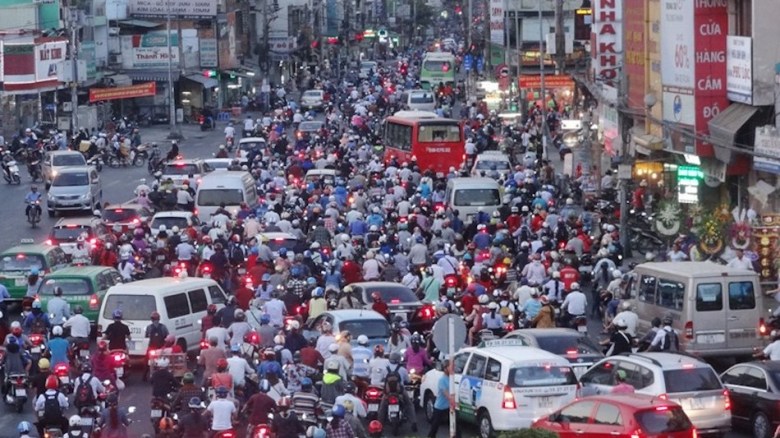“If I miss one exit, can I reverse my car on [the] expressway?” is a question posed on the new Twitter page for the Phnom Penh-Sihanoukville Expressway, Cambodia’s first proper motorway that is expected to open next year.
“Absolutely not,” was the answer. “You need to pay close attention to the signs on the expressway.” Another asked: “If I need to use [the] toilet, can I stop the car on [the] expressway?” The answer: “No. On the expressway, the driving speed is nearly 100km/h.”
There’s a good reason why authorities are preparing safety campaigns now. Last year there were more than 1,500 fatalities from road accidents in Cambodia, making it the leading cause of deaths in the country.
Interior Minister Sar Kheng, announcing these statistics on January 1, pointed to the positives.
The number of deaths on Cambodia’s roads last year was down from about 1,600 in 2020, he stated, which in turn was down from about 2,000 in 2019. But to put that into some perspective, there have been just over 3,000 deaths in Cambodia from Covid-19 since the beginning of the pandemic, making road travel more perilous.
The analogy isn’t a perverse one. Writing in November 2020, Jitlakha Sukruay, a researcher at the Thailand Development Research Institute, argued that “if we go by the number of deaths, the coronavirus is not the country’s biggest public health problem. Road accidents are.”
Back in 2011, a World Health Organization (WHO) study called road-traffic injuries the “Silent Epidemic” in Southeast Asia. In our latest jargon, it could be called Southeast Asia’s persistent “pandemic.”

The leading cause of death
Across much of Southeast Asia, road traffic accidents are the leading cause of deaths and injuries. According to the WHO’s database of 2019, Thailand and Vietnam were the most perilous countries in the region, with a death rate of 32.2 and 30.5 people, respectively, per 100,000.
Next on the list were Malaysia (22.4 per 100,000), Myanmar (20.3), Cambodia (19.5) and Laos (17.8). Only two Singaporeans per 100,000 die on average from road accidents, by comparison.
On the one hand, there does appear to be some improvement of late, although it’s difficult to know if a decline in deaths on Southeast Asia’s roads in 2020 and again in 2021 is because of better safety measures or simply because fewer people traveled as a result of the pandemic.
In Vietnam, more than 5,800 people died last year from road accidents, a decrease of 15.5% from 2020, according to the Office of the National Traffic Safety Committee.
According to a report published last June by the United Nations Development Program and Cambodia’s National Road Safety Committee, “the number of fatalities caused by road traffic accidents has increased nearly 25% over the past 11 years (2009-2019), higher than the population growth for the same period of 17%.”
It also estimated an economic cost of these fatalities: about US$466 million each year, or 1.7% of Cambodia’s gross domestic product (GDP).
For Vietnam, the latest estimate was 2.9% of GDP, made back in 2012. A 2017 study by the World Bank, The High Toll of Traffic Injuries, suggested that if Thailand could cut road traffic mortality rates by 50% over a period of 24 years, it could generate additional income equivalent to 22.2% of GDP – of the 2014 level.
Using the same parameters, the Philippines could boost income by the equivalent of 7.2% of GDP.
Experts say Southeast Asia’s perilous roads are a result of several factors, as is usually the case. Most deaths are of motorcycle riders, the main users of the region’s roads. Then there’s road safety knowledge.

More cars on the roads
Sar Kheng, the Cambodia interior minister, said this month that 38% of road deaths in 2021 were caused by speeding and 24% by not respecting other vehicles’ right of way. The poor state of roads across the region is another factor, as is a lack of police enforcement of road violations.
On the one hand, as Southeast Asians become wealthier it is likely there will be an increase in the number of car users, a far safer mode of transport. The 2021 Global Automotive Consumer Study of Southeast Asia perspectives, published last April by Deloitte, found that before Covid-19 an average 37% of overall Southeast Asian consumers preferred to commute by personal vehicles.
After the outbreak of the pandemic, this increased to 52%. Interestingly, some 87% of Southeast Asia respondents said the advanced feature they most want in a new car is a blind spot warning, no doubt to spot the legion of motorcycles that wind their way around Southeast Asia’s streets.
Corruption and a lack of driving skills also play a big part in the region’s high road toll. Many people do not learn safe driving skills – or any driving skills – and simply pay a bribe to get a license.
Then they buy a car and take to the streets, which are often crowded with motorcycles weaving their way through traffic. Driving in these conditions is not for the faint-hearted. Or the untrained.

On the other hand, the Covid-19 pandemic may be the spur needed to pressure the authorities to actually tackle Southeast Asia’s more persistent pandemic. In October 2020, the Economist argued, perhaps too soon, that the pandemic had “exposed South-East Asia’s poor governance.”
That may be true in some countries, namely Thailand and the Philippines, but others have demonstrated that their bureaucracies can cope well in times of crisis.
Cambodia, where the bureaucracy wasn’t thought to be up to scratch before the pandemic, has been a star performer at containing the outbreak and, especially, with its vaccination campaign.
Vietnam won international plaudits in 2020 before coming unstuck the following year. Malaysia, after struggling in 2020, has excelled at vaccinating its populace. One outcome of the Covid-19 pandemic could be that Southeast Asian publics now expect their government to continue the good work in other areas.
Follow David Hutt on Twitter at @davidhuttjourno


